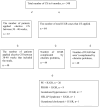High amniotic fluid fractalkine and MIP-1β levels are associated with intrauterine growth restriction: a prospective cohort study
- PMID: 38812616
- PMCID: PMC11031143
- DOI: 10.55730/1300-0144.5789
High amniotic fluid fractalkine and MIP-1β levels are associated with intrauterine growth restriction: a prospective cohort study
Abstract
Background/aim: Proinflammatory chemokines have been shown to play crucial roles in implantation, spiral artery invasion, and the fetomaternal immunological response. In this context, we investigated the levels of fractalkine (CX3CL1) and chemokine CC motif ligand 4 (CCL4 or MIP-1β) in maternal serum and amniotic fluids in pregnant women with intrauterine growth restriction (IUGR).
Materials and methods: This prospective cohort study was carried out at Fırat University Obstetrics Clinic between January 1, 2022 and July 1, 2022. Group (G) 1: The control group consisted of 40 pregnant women who underwent elective cesarean section (CS) at 38-40 weeks of gestation. G2: A total of 40 pregnant women with IUGR at 28-37 weeks of gestation were included in the study group. Levels of tumor necrosis factor-alpha (TNF-α), interleukin-1 beta (IL-1β), interferon-gamma (IFN-γ), hypoxia-inducible factor-1 alpha (HIF-1α), macrophage inflammatory protein-1 beta (MIP-1β), and fractalkine were measured in maternal serum and amniotic fluid samples obtained during CS.
Results: When maternal age was compared, no statistically significant difference was observed between G1 and G2 (p = 0.374). The number of gravidity was found to be statistically higher in G1 compared to G2 (p = 0.003). The mean gestational week was statistically higher in G1 (p < 0.001). Maternal serum MIP-1β (p = 0.03) and IFN-γ (p = 0.006) levels were higher in G1. The birth weight of the baby (p < 0.001) and umbilical cord blood gas pH value (p < 0.001) at birth were higher in G1. HIF-1α (p < 0.001), fractalkine (p < 0.001), MIP-1β (p < 0.001), TNF-α (p = 0.007), IL-1β (p < 0.001), and IFN-γ levels (p = 0.007) in amniotic fluid were higher in G2.
Conclusion: Elevated levels of proinflammatory factors, including fractalkine and MIP-1β, along with inflammatory factors such as TNF-α, IL-1β, and IFN-γ, as well as increased HIF-1α levels in amniotic fluid, are associated with intrauterine growth restriction (IUGR) attributed to a hypoxic amniotic environment.
Keywords: HIF-1α; IUGR; MIP-1β; amniotic fluid; fractalkine; inflammation.
© TÜBİTAK.
Conflict of interest statement
Conflict of interest: The authors declare that they have no conflicts of interest to disclose.
Figures
Similar articles
-
Differences in amniotic fluid and maternal serum cytokine levels in early midtrimester women without evidence of infection.Cytokine. 2008 Oct;44(1):78-84. doi: 10.1016/j.cyto.2008.06.009. Epub 2008 Aug 13. Cytokine. 2008. PMID: 18703348
-
Mid-trimester maternal serum and amniotic fluid biomarkers for the prediction of preterm delivery and intrauterine growth retardation.J Obstet Gynaecol Res. 2014 Jun;40(6):1540-6. doi: 10.1111/jog.12371. J Obstet Gynaecol Res. 2014. PMID: 24888913 Clinical Trial.
-
Gene expression and production of tumor necrosis factor alpha, interleukin-1beta (IL-1beta), IL-8, macrophage inflammatory protein 1alpha (MIP-1alpha), MIP-1beta, and gamma interferon-inducible protein 10 by human neutrophils stimulated with group B meningococcal outer membrane vesicles.Infect Immun. 2000 Dec;68(12):6917-23. doi: 10.1128/IAI.68.12.6917-6923.2000. Infect Immun. 2000. PMID: 11083814 Free PMC article.
-
Effects of amniotic and maternal CD-146, TGF-β1, IL-12, IL-18 and IFN-γ, on adverse pregnancy outcome.J Matern Fetal Neonatal Med. 2013 Jan;26(1):21-5. doi: 10.3109/14767058.2012.722712. Epub 2012 Sep 11. J Matern Fetal Neonatal Med. 2013. PMID: 22913276
-
The clinical value of IL-3, IL-4, IL-12p70, IL17A, IFN-γ, MIP-1β, NLR, P-selectin, and TNF-α in differentiating bloodstream infections caused by gram-negative, gram-positive bacteria and fungi in hospitalized patients: An Observational Study.Medicine (Baltimore). 2019 Sep;98(38):e17315. doi: 10.1097/MD.0000000000017315. Medicine (Baltimore). 2019. PMID: 31568018 Free PMC article.
Cited by
-
Comparison of maternal neonatal outcomes of normotensive and hypertensive placental abruptions: A novel approach.Medicine (Baltimore). 2024 Jun 28;103(26):e38633. doi: 10.1097/MD.0000000000038633. Medicine (Baltimore). 2024. PMID: 38941372 Free PMC article.
References
-
- Fetal Growth Restriction: ACOG Practice Bulletin, Number 227. Obstetrics and Gynecology. 2021;137(2):e16–e28. https://doi:10.1097/AOG.0000000000004251 . - DOI - PubMed
-
- Gordijn SJ, Beune IM, Thilaganathan B, Papageorghiou A, Baschat AA, et al. Consensus definition of fetal growth restriction: a Delphi procedure. Ultrasound in Obstetrics and Gynecology. 2016;48(3):333–339. https://doi:10.1002/uog.15884 . - DOI - PubMed
-
- Ruiz-Martinez S, Papageorghiou AT, Staines-Urias E, Villar J, Gonzalez De Agüero R, et al. Clinical impact of Doppler reference charts on management of small-for-gestational-age fetuses: need for standardization. Ultrasound in Obstetrics and Gynecology. 2020;56(2):166–172. https://doi:10.1002/UOG.20380 . - DOI - PubMed
-
- Burton GJ, Jauniaux E. Pathophysiology of placental-derived fetal growth restriction. American Journal of Obstetrics and Gynecology. 2018;218(2S):745–761. https://doi:10.1016/j.ajog.2017.11.577 . - DOI - PubMed
-
- Labarrere CA, DiCarlo HL, Bammerlin E, Hardin JW, Kim YM, et al. Failure of physiologic transformation of spiral arteries, endothelial and trophoblast cell activation, and acute atherosis in the basal plate of the placenta. American Journal of Obstetrics and Gynecology. 2017;216(3):287.e1–287.e16. https://doi:10.1016/j.ajog.2016.12.029 . - DOI - PMC - PubMed
MeSH terms
Substances
LinkOut - more resources
Full Text Sources
Research Materials
Miscellaneous



